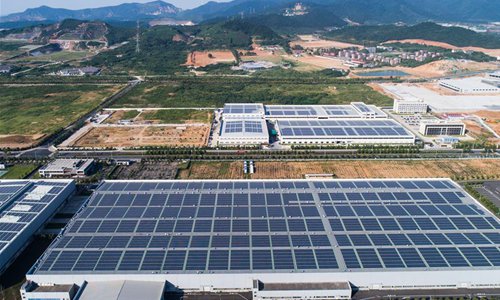China to bolster energy security despite COVID-19 pandemic: NDRC
By Wang Sheng Source:Global Times Published: 2020/6/18 17:04:08

Aerial photo taken on Sept. 19, 2019 shows solar panels on the rooftop of a local automobile maker in Huzhou, east China's Zhejiang Province. New energy sources including distributed photovoltaic systems and wind farms have taken increased shares in the power supply of Huzhou since the city adopted a low-carbon development plan. (Xinhua/Xu Yu)
China is implementing a series of guidelines in the energy sector to guarantee energy security and promote energy transition, according to an annual energy work schedule released on Thursday by the National Development and Reform Commission, China's top economic planner.
The guidelines prioritize energy security and require the oil and gas sector to stabilize production by increasing investment in enhancing oil and gas exploration including shale oil, tight gas and coalbed gas in Bohai Bay, Erdos and Tarim.
The document requires the coal sector to consistently optimize coal production structure, expand the qualified coal supply and scientifically develop downstream industries like coal-fired power and coal chemicals. It noted that coal mines should promote the mechanization, automation, informatization and intelligent operations.
In addition to developing coal-fired power, the guidelines recommend the electricity sector should push forward solar and wind power generation to reach grid parity, and develop hydro and nuclear power under the premise of guaranteeing electricity consumption to diversify the electricity production structure.
"In 2020, the installed capacity of hydropower will reach 340 million kilowatts, and wind and solar power will each reach 240 million kilowatts," it noted.
Significantly, the guidelines require the Chinese energy industry to expand transport and storage capacities as well. Specifically, the coal sector should promote transport by train, and the oil and gas sector should facilitate the interconnectivity of pipelines via "a nationwide network."
In addition to increasing the gas storage capacity, the coal sector should create an additional 30 million tons of coal storage capacity this year.
The guidelines also highlight energy transition to increase the resilience of the energy industry and develop a safe, green and efficient energy system.
This year, China should further cut the capacity of coal production, particularly producers under an annual capacity of 300,000 tons and unable to comply with rules on security and environmental protection, according to the document.
Furthermore, China will ensure the needs of coal-to-gas users and pay attention to energy saving in areas including construction, transportation and public agencies.
"It's the first time that China has pursued energy security and transition by making an annual work guideline paper. From a historical perspective, energy security should be a prominent concern in the energy sector," Liu Yijun, a professor at the China University of Petroleum, told the Global Times on Thursday.
Posted in: INDUSTRIES,ECONOMY,MORE